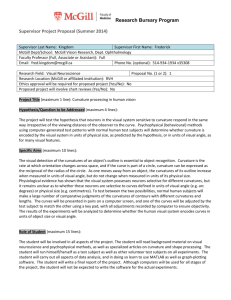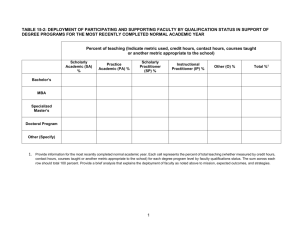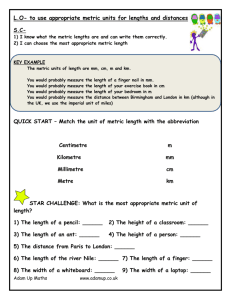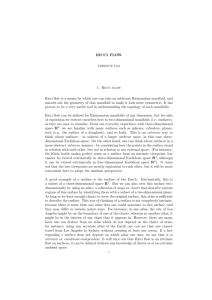Construction of manifolds of positive Ricci curvature with big volume
advertisement
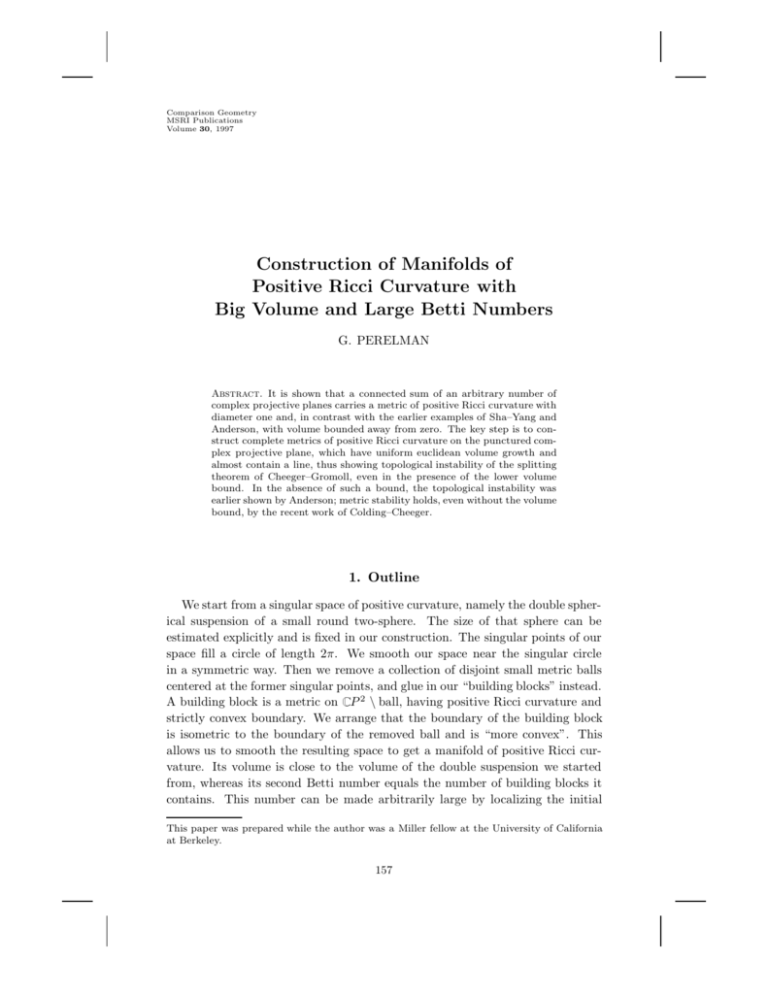
Comparison Geometry
MSRI Publications
Volume 30, 1997
Construction of Manifolds of
Positive Ricci Curvature with
Big Volume and Large Betti Numbers
G. PERELMAN
Abstract. It is shown that a connected sum of an arbitrary number of
complex projective planes carries a metric of positive Ricci curvature with
diameter one and, in contrast with the earlier examples of Sha–Yang and
Anderson, with volume bounded away from zero. The key step is to construct complete metrics of positive Ricci curvature on the punctured complex projective plane, which have uniform euclidean volume growth and
almost contain a line, thus showing topological instability of the splitting
theorem of Cheeger–Gromoll, even in the presence of the lower volume
bound. In the absence of such a bound, the topological instability was
earlier shown by Anderson; metric stability holds, even without the volume
bound, by the recent work of Colding–Cheeger.
1. Outline
We start from a singular space of positive curvature, namely the double spherical suspension of a small round two-sphere. The size of that sphere can be
estimated explicitly and is fixed in our construction. The singular points of our
space fill a circle of length 2π. We smooth our space near the singular circle
in a symmetric way. Then we remove a collection of disjoint small metric balls
centered at the former singular points, and glue in our “building blocks” instead.
A building block is a metric on C P 2 \ ball, having positive Ricci curvature and
strictly convex boundary. We arrange that the boundary of the building block
is isometric to the boundary of the removed ball and is “more convex”. This
allows us to smooth the resulting space to get a manifold of positive Ricci curvature. Its volume is close to the volume of the double suspension we started
from, whereas its second Betti number equals the number of building blocks it
contains. This number can be made arbitrarily large by localizing the initial
This paper was prepared while the author was a Miller fellow at the University of California
at Berkeley.
157
158
G. PERELMAN
smoothing of the double suspension to smaller neighborhoods of the singular
circle, and by removing a larger number of smaller balls.
The main difficulty is to construct building blocks. This is carried out in
Section 2. In Section 3 we construct the ambient space, i.e., we make precise
the relation between the number and the size of balls to be removed and the
smoothing of our double suspension. In Section 4 we explain how to smooth
the result of gluing two manifolds with boundaries, so as to retain positive Ricci
curvature.
Notation. K(X ∧ Y ) denotes the sectional curvature in the plane spanned by
X, Y . We abbreviate Ric(X, Y )/|X||Y | as Ri(X, Y ).
2. Construction of the Building Block
Our building block is glued from two pieces: the core and the neck. The
core is a metric on C P 2 \ ball with positive Ricci curvature and strictly convex
boundary; moreover, the boundary is isometric to a round sphere. The neck is
a metric on S 3 × [0, 1] with positive Ricci curvature, such that the boundary
component S 3 × {0} is concave and is isometric to a round sphere, whereas the
boundary component S 3 × {1} is convex and looks like a lemon, that is, like
a smoothed spherical suspension of a small round two-sphere. There are some
additional conditions on the normal curvatures of the boundary of the neck; they
will be made clear below.
Construction of the core. It is well known that the canonical metric of C P 2
in a neighborhood of C P 1 can be expressed as
ds2 = dt2 + A2 (t) dx2 + B 2 (t) dy2 + C 2 (t) dz 2 ,
where t is the distance from C P 1 and X, Y, Z is the standard invariant framing
of S 3 , satisfying [X, Y ] = 2Z, [Y, Z] = 2X, [Z, X] = 2Y . The canonical metric
has A = sin t cos t and B = C = cos t, but we are going to consider general
A, B, C.
The curvature tensor in this presentation is listed on page 165 of this volume.
Assuming now that B ≡ C, we deduce from those formulas that
Ri(X,X) = (−A00/A − 2A0 B 0/AB + 2A2/B 4 ),
Ri(Y, Y ) = Ric(Z, Z) = (−B 00/B − A0 B 0/AB − B 02/B 2 + (4B 2 − 2A2 )/B 4 ),
Ri(T, T ) = (−A00/A − 2B 00/B),
and all off-diagonal entries vanish.
1
cosh(t/100). Clearly this choice gives a
Now let A = sin t cos t, B = 100
1
,
smooth metric. We have, for 0 < t < 10
−A00 /A = 4,
−B 00 /B = −10−4 ,
0 < A0 B 0 /AB <
and (4B 2 − 2A2 )/B 4 > 100 provided that A ≤ B.
1
,
10
0 < B 0 /B <
1
,
100
BIG POSITIVELY CURVED MANIFOLDS WITH LARGE BETTI NUMBERS 159
1
Thus if 0 < t0 < 10
is such that A(t0 ) = B(t0 ), A(t) < B(t) for t < t0 , then
Ricci curvatures are positive for 0 ≤ t ≤ t0 . Such t0 exists because A(0) = 0 <
1
1
1
) > 20
> B( 10
). Therefore the core is constructed.
B(0), whereas A( 10
Construction of the neck. We first prove the following result.
Assertion. Let (S n , g) be a rotationally symmetric metric of sectional curvature
> 1, distance between the poles πR and waist 2πr; that is, g can be expressed as
ds2 = dt2 +B 2 (t) dσ 2 , where dσ 2 is the standard metric of S n−1 , t ∈ [0, πR], and
maxt B(t) = r. Let ρ > 0 be such that ρ < R and rn−1 < ρn . Then there exists
a metric of positive Ricci curvature on S n × [0, 1] such that (a) the boundary
component S n × {1} has intrinsic metric g and is strictly convex ; moreover , all
its normal curvatures are > 1; (b) the boundary component S n × {0} is concave,
with normal curvatures equal to −λ, and is isometric to a round sphere of radius
ρλ−1 , for some λ > 0.
(Note that, if ρ is small enough, the core constructed earlier in this section can
be glued, after rescaling, to the neck along S n × {0}, so that the resulting space
can be smoothed with positive Ricci curvature; see Section 4.)
To prove the assertion, we start by rewriting our metric g in the form
ds2 = r 2 cos2 x dσ 2 + A2 (x) dx2 ,
where −π/2 ≤ x ≤ π/2 and A is a smooth positive function satisfying A(±π/2) =
r, A0 (±π/2) = 0. Clearly A(x) ≥ R > r for some x, so we can write
A(x) = r(1 − η(x) + η(x) · a∞ ),
where maxx η(x) = 1 and a∞ ≥ R/r, η(±π/2) = 0, and ηx0 (±π/2) = 0.
Consider a metric on S n × [t0 , t∞] of the form
ds2 = dt2 + A2 (t, x) dx2 + B 2 (t, x) dσ 2 ,
where B = tb(t) cos x, A = tb(t) 1 − η(x) + η(x)a(t) , a(t0 ) = 1, a0 (t0 ) = 0,
b(t0 ) = ρ, b0 (t0 ) = 0, a(t∞ ) = a∞ > 1, b(t∞ ) > r. That metric will satisfy the
conditions of our assertion after rescaling by a multiple r/(t∞ · b(t∞ )), provided
that the functions a(t) and b(t) are chosen appropriately.
The curvatures of our metric can be computed as follows:
K(T ∧ X) = −Att /A
K(T ∧ Σ) = −Btt /B
K(X ∧ Σ) = −At Bt /AB + Ax Bx /A3 B − Bxx /BA2
K(Σ1 ∧ Σ2 ) = 1/B 2 − Bx2 /A2 B 2 − Bt2 /B 2 ,
and the Ricci tensor has only one nonzero off-diagonal term, namely
Ri(T, X) = (n − 1)(At Bx /A2 B − Bxt /AB).
160
G. PERELMAN
Further computations give
Ri(T, T ) = −n
2b0
b00
+
b
tb
Ri(T, X) = −(n − 1) tg x
−
2ηa0
b0
ηa0
ηa00
+
+2
,
1 − η + ηa t(1 − η + ηa)
b 1 − η + ηa
ηa0
tb(1 − η + ηa)2
for the Ricci tensor, and
1
K(X ∧ Σ) = 2 2
t b
ηx tg x (a − 1)
1
−
2
(1 − η + ηa)
(1 − η + ηa)3
−
K(Σ1 ∧ Σ2 ) =
1
t2 b 2
tg2 x
1
−
2
cos x (1 − η + ηa)2
1 b0
+
t
b
−
1 b0
+
t
b
ηa0
1 b0
+ +
,
t
b
1 − η + ηa
2
for the sectional curvatures. Note that the first terms in the last two formulas are
the intrinsic curvatures of the hypersurfaces t = const, Ki (X ∧ Σ), Ki (Σ1 ∧ Σ2 ).
We construct the functions b(t) and a(t) as follows:
b0 /b = −β(t − t0 )/2t20 log 2t0 for t0 ≤ t ≤ 2t0 ,
b0 /b = −β log 2t0 /t log2 t for t ≥ 2t0 (b must be smoothed near t = 2t0 ),
a0 /a = −αb0 /b for t ≥ t0 .
(1 + δ)β −1 log a∞ /(1 +
Here β = (1 − ε)(log ρR− log r)/(1 + 1/(4 log 2t0 )) and α =
R∞
∞ 0
1/(4 log 2t0 )), so that t0 b /b = (1−ε)(log r−log ρ) and t0 a0 /a = (1+δ) log a∞ ;
the small positive numbers ε, δ are to be determined later.
At this point we still have freedom in the choice of t0 , ε, δ, and t∞ . Note, however, that t∞ is determined by δ from the relation a(t∞ ) = a∞ . We choose ε > 0
first in such a way that the metric (ρ/r)ε · g still has sectional curvatures > 1.
In this situation we prove below that the curvatures Ki (X ∧ Σ) and Ki (Σ1 ∧ Σ2 )
can be estimated from below by c/t2 for some c > 1 independent of t0 , t∞ , and
δ. Then we show that the Ricci curvatures of our metric are strictly positive if
t0 is chosen large enough, independently of δ, if δ is small. Finally, we choose
δ in such a way that the normal curvatures of S n × {t∞ } are sufficiently close
to t−1
∞ .
First of all we need to check that 1 < α < n. Indeed, at the maximum point
of η(x) we have tg x ηx = 0, so Kg (X ∧ Σ) = 1/r 2 a2∞ . Thus a∞ < 1/r and
log a∞ < n(log ρ − log r) since r n−1 < ρn . On the other hand a∞ ≥ R/r > ρ/r,
so log a∞ > log ρ − log r.
Now we are in a position to check that Ki (X ∧ Σ) ≥ c/t2 and Ki (Σ1 ∧ Σ2 ) ≥
c/t2 for some c > 1. Let ψ = log t2 Ki (Σ1 ∧ Σ2 ) . We know that ψ|t=t0 > 0 and
BIG POSITIVELY CURVED MANIFOLDS WITH LARGE BETTI NUMBERS 161
ψ|t=t∞ > 0. A computation gives
αηa sin2 x
2b0
.
1+
ψt = −
b
(1 − η + ηa)((1 − η + ηa)2 − sin2 x)
This expression is positive if η ≥ 0, and it is decreasing in a if η < 0. Therefore
ψ cannot have a local minimum on
(t0 , t∞ ) for any fixed x, so ψ > 0 as required.
Now let φ = log t2 Ki (X ∧ Σ) . Again consider the behavior of this function
for t ∈ [t0 , t∞ ] and fixed x. Suppose that tg x ηx ≥ 0. A computation gives
1
αa tg x ηx
b0
2(1 − η) + 2ηa(1 − α) −
φt = −
b 1 − η + ηa
1 − η + tg x ηx + a(η − tg x ηx)
0
αa
tg x ηx
b
2−
2η +
.
=−
b
1 − η + ηa
1 − η + tg x ηx + a(η − tg x ηx)
If η ≥ 0 the first expression in large brackets is clearly decreasing in a, whereas
if η < 0 the second expression in brackets, and also αa/(1 − η + ηa), are clearly
increasing in a, so φ cannot have a local minimum in (t0 , t∞ ), and therefore
φ > 0 since φ|t=t0 > 0 and φ|t=t∞ > 0. Now suppose that tg x ηx < 0. Then
φ > −2 log ab > 0, because a(t∞ )b(t∞ ) < 1 and log(ab) is increasing in t (note
that log(ab)0 = −(b0 /b)(α −1) > 0). The estimate for Ki (X ∧Σ) and Ki (Σ1 ∧Σ2 )
is proved.
Now we can estimate the Ricci curvatures of our metric. Note that the normal
curvatures 1/t + b0 /b and 1/t + b0 /b + ηa0 /(1 − η + ηa) can be estimated by
1/t + O(1/t log t). It follows that K(X ∧ Σ) ≥ c/t2 and K(Σ1 ∧ Σ2 ) ≥ c/t2 ,
for c > 0. It is also clear that |Ri(T, X)|, |K(X ∧ T )|, and |K(Σ ∧ T )| are all
bounded above by c log t0 /(t2 log2 t); hence, in particular, Ri(X, X) ≥ c/t2 and
Ri(Σ, Σ) ≥ c/t2 , with c > 0.
To estimate Ri(T, T ), write it as
2 b0
αηa
−n
(b0 /b)0 +
Ri(T, T ) =
1 − η + ηa
t b
ηa
b 0 a0
+
2
− n(b /b) −
1 − η + ηa
b a
0
2
a0 2 a
.
Note that, since η ≤ 1 and α < n, the first multiple is negative and bounded
away from 0. Therefore, the first term is ≥ c log t0 /(t2 log2 t), for c > 0. The
remaining terms are of order c log2 t0 /(t2 log4 t), so we get
Ri(T, T ) ≥
c log t0
.
t2 log2 t
Since |Ri(T, X)| ≤ cRi(T, T ) Ri(X, X), we conclude that Ricci curvature is
positive, if t0 was chosen large enough.
To complete the construction it remains to choose δ > 0 so small, and correspondingly t∞ so large, that normal curvatures of S n × {t∞ } are > (r/ρ)ε t−1
∞ ;
this is possible since they are estimated by 1/t + O(1/t log t).
162
G. PERELMAN
3. Construction of the Ambient Space
The metric of the double suspension of a sphere of radius R0 near singular
circle can be written as
ds2 = dt2 + cos2 t dx2 + R2 (t) dσ 2 ,
where t ≥ 0 is the distance from the singular circle, R(t) = R0 sin t. We smooth
this metric by modifying R(t) in such a way that R(0) = 0, R0 (0) = 1, and
R00 (0) = 0. The curvatures of this metric are easily computed to be K(T ∧ X) =
1, K(T ∧ Σ) = −R00 /R, K(X ∧ Σ) = (R0/R) tg t, K(Σ1 ∧ Σ2 ) = (1 − R02 )/R2 ,
and all mixed curvatures in this basis vanish. We will choose R(t) in such a way
that 1 > R0 > 0 and R00 < 0 when t > 0, thus making all sectional curvatures
positive.
Consider a metric ball of small radius r0 centered on the axis t = 0. We
assume that −R00 ≥ R for 0 ≤ t ≤ r0 , so that K(T ∧ Σ) ≥ 1. In this case
the normal curvatures of the boundary of this ball do not exceed ctg r0 . We’ll
show that the function R(t) can be chosen so that the intrinsic curvatures of the
boundary are strictly bigger than ctg2 r0 . It would follow that for sufficiently
small R0 > 0, we can construct a building block that, after rescaling by tg r0 ,
can be glued (using the results of Section 4) in our ambient space instead of the
metric ball.
At a point of the boundary of our metric ball, which is at a distance t from
the axis, we can compute the intrinsic curvatures as follows:
Ki (Σ1 ∧ Σ2 ) = (1/R2 )(1 − R02 sin2 φ),
Ki (Y ∧ Σ) = −
R00
R0
R0
sin2 φ +
tg t cos2 φ + ctg r0
cos φ,
R
R
R
where Y ∈ X ∧ T is a tangent vector to the boundary, φ is the angle between T
and the normal vector, cos φ = ctg r0 tg t.
Since K(T ∧ Σ) ≥ 1, it follows from the comparison theorem that
Ki (Σ1 ∧ Σ2 ) ≥ 1/ sin2 t − ctg2 t(1 − cos2 φ) = 1 + ctg2 r0 > ctg2 r0 .
To make sure that Ki (Y ∧ Σ) > ctg2 r0 , we have to choose R(t) more carefully.
Namely, let R(t) = R0 sin t + δ γ(t/r0 − 1)) for t ≥ ε, where γ is a standard
smooth function interpolating between γ(x) = 1 for x ≤ 0 and γ(x) = 0 for
x ≥ 1. Extend R(t) to the segment [0, ε] in such a way that R(0) = 0, R0 (0) = 1,
and −R00 /R ≥ 2r0−2 on [0, ε]. (This is possible with an appropriate choice of ε
and δ—for example, if ε = 12 r02 and δ = 14 r04 .) Now it is clear that already the
first term in the expression for Ki (Y ∧ Σ) is bigger than ctg2 r0 if 0 ≤ t ≤ ε. For
ε ≤ t ≤ r0 we have
Ki (Y ∧ Σ) = sin2 φ + ctg(t + δ) tg t cos2 φ + ctg2 r0 ctg(t + δ) tg t
≥ ctg(t + δ) tg t (ctg2 r0 + 1).
BIG POSITIVELY CURVED MANIFOLDS WITH LARGE BETTI NUMBERS 163
So we need to check that tg(t + δ)/ tg t < 1 + tg2 r0 . This is true for t ≥ ε = 12 r02
and δ = 14 r04 and for small r0 . Thus, both Ki (Σ1 ∧ Σ2 ) and Ki (X ∧ Σ) are bigger
than ctg2 r0 , and the construction of the ambient space is complete.
4. Gluing and Smoothing
To justify gluing and smoothing in our construction we need the following
fact.
Let M1 , M2 be compact smooth manifolds of positive Ricci curvature, with
isometric boundaries ∂M1 ' ∂M2 = X. Suppose that the normal curvatures
of ∂M1 are bigger than the negatives of the corresponding normal curvatures of
∂M2 . Then the result M1 ∪X M2 of gluing M1 and M2 can be smoothed near X
to produce a manifold of positive Ricci curvature.
To prove this, express the metric of M1 ∪X M2 in normal coordinates with
respect to X; let t be the normal coordinate. Introduce a small parameter
τ > 0, and for arbitrary coordinate vectors X1 , X2 tangent to X replace our given
function hX1 , X2 i(x, t) by its interpolation on the segment [−τ, τ ]. At first we can
take a C 1 interpolation given by a cubic polynomial in t, whose coefficients are
linear functions of hX1 , X2 i(x, ±τ ) and hX1 , X2 i0t (x, ±τ ). Clearly this procedure
is independent of the choice of coordinates in X, and it gives a C 1 metric, which
is C 2 outside two hypersurfaces Xτ , X−τ , corresponding to t = ±τ . It is easy
to see that in the segment [−τ, τ ] we get all K(T ∧ X) positive of order cτ −1
and all K(X1 ∧ X2 ) and Ri(T, X) bounded, so the Ricci curvature is positive.
Now we can use a similar procedure to smooth our manifold near hypersurfaces
t = ±τ . This time we choose another τ 0 τ and construct a C 2 -interpolation.
It is clear that only the components R(T, · , · , T ) of the curvature tensor were
discontinuous on, say, Xτ , and, up to an error of order τ 0 , these components now
interpolate linearly between their original values on the different sides of Xτ .
Since positivity of Ricci curvature is open and convex condition, the smoothed
manifold has positive Ricci curvatures.
G. Perelman
St. Petersburg Branch
V. A. Steklov Institute of Mathematics (POMI)
Russian Academy of Sciences
Fontanka 27
St. Petersburg, 191011
Russia
perelman@pdmi.ras.ru

